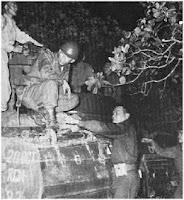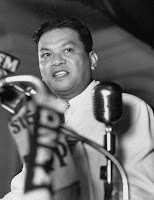
Carlos P. Garcia was born on November 4, 1896 and became president of the Philippines on March 23, 1957 after President Ramon Magsaysay died in a plane crash. He was elected December 30th that same year to a full term as the 8th president of the Philippines. Before he took office as president he was a teacher, lawyer and public official. Garcia become well known for his “Filipino First” policy in which he placed the well-being and interests of the Filipino people above any foreigners and those belonging to the majority ruling party.
Garcia was born in Talibon, Bohol. He went to Cebu Provincial High School and Silliman University then got his law degree at the Philippine Law School. Instead of practicing law immediately, Garcia worked as a teacher at Bohol Provincial High School. Garcia was also notable for his poetry in Bohol that people referred to him as the “Prince of Visayan Poets” and the “Bard from Bohol.”
Carlos P. Garcia began his political career as elected as a representative to the Philippine congress in 1925. Thereafter, he was elected governor of Bohol in 1931 and was re-elected in 1940. He became senator in 1941. Garcia was elected for senate for three consecutive terms between 1941-1953.

Garcia was appointed vice-president as his running mate; Ramon Magsaysay won the election for presidency in 1953. The President then appointed him Secretary of Foreign Affairs for four years while serving his term as vice president at the same time. Garcia assumed presidency following President Magsaysay’s death. After he completed Magsaysay’s term he was elected as the 8th president of the Philippines.
President Carlos P. Garcia is most notably remembered for his “Filipino First Policy” which is a policy that favored Filipino businessmen and citizens over foreign investors and competition. This meant that foreign investors could invest up to 40% in an industry or business while the remaining 60% would be owned by Filipino citizens. Garcia’s policies aimed at stimulating economic growth and prosperity, ultimately obtaining and sustaining economic independence. This included managing retail trade, which affected relations with Chinese business. Among other things, Garcia also tried revitalizing Filipino cultural traditions. He also tried instilling the Austerity Program, which although not as successful as his other policies, attempted to fix the corruption in the government. This helped restore trust between the Filipino people and the government.
Towards the end of his second term, Garcia ran for re-election but was defeated by Macapagal. He retired to life as a private citizen in Bohol and was elected to be a delegate of the Constitutional convention. Shortly thereafter though, Garcia suffered a fatal heart attack and passed away on June 14, 1971.
-V. Armas




-assemblage--_by_Alfonso_A._Ossorio,_1967.jpg)



+(1).jpg)















